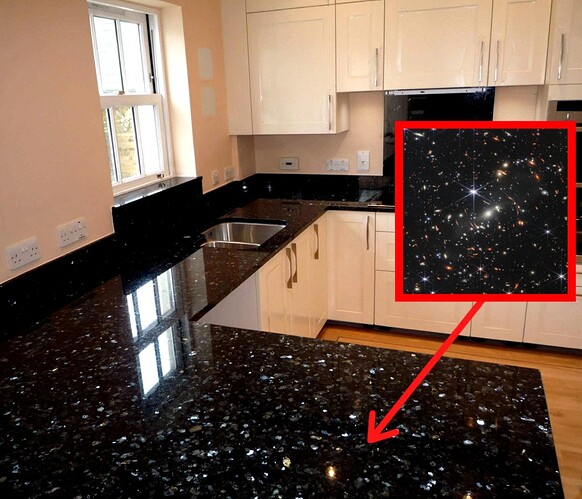Left my IR/X-Ray/Cosmic ray eyes at home today 
So are you suggesting that the universe might actually be an unimaginably large kitchen worktop?
And if so, might that imply that the ‘cosmic watchmaker’ was actually a chef?
Questions, questions…
You know it makes sense 
His son was a carpenter so maybe he made kitchen cabinets?
Ah! Now we’re getting somewhere, but it may be still be premature to inform NASA.
Chinese story I was told as small child: supreme being makes little men and women out of dough, first batch stay in hot oven too long, oops they burn black; turn down heat for second batch oops they come out nasty pasty white; third batch is (naturally) just right they are a beautiful golden colour.
Hmm - so was the Creator a watchmaker, a chef, or a carpenter?
Almost as soon as any religious debate develops, schism occurs, but hey doesn’t that sum up the history of Christianity (and Islam etc.)
Ish.
The telescope, for all its complexity is just a large reflector, and takes pictures just the same way that any large reflector connected to a digital sensor does. The false colour (technically not “shifted in spectrum”) images are made by taking IR pictures through three different wavelength IR filters and then mapping the three channels so produced to RGB.
If you want you can actually download the raw data and judge for yourself how much image manipulation has taken place
See here for details.
The images are in “fits” format and rather large though so make sure you have a fast internet connection and plenty of disk space as well as an insatiable curiosity to see what the raw JWST image data looks like ![]()
These are Webb’s instruments…
Yes, there are multiple (not necessarily 3, I’ve seen some as many as 6) channels that are processed to create the final visible image. I was making the point that the frequency of the original image had to be shifted into the visible portion of the spectrum.
I’ll have a look at the original fits images, they should be very interesting. I work with fits images, so have stacking and image processing software that can handle them. I typically work with image sets of about 5 to 20GB, and I can handle much larger ones if necessary.
I think this thread now has two channels, explanatory astrophysics and implausible metaphysics.
But no schism, they can happily co-exist…
It’s nit picking, I know, but I’d phrase it as “represented” rather than shifting, especially if more than three channels went into the composite.
Actually, I said “filters” above and that *might* be true (it came from the BBC Horizon documentary last night) but I note that the JWST actually has more than one sensor - so some of the images might be composited from different sensors rather than one sensor with different filters.
Who decides the RGB colours that are assigned to the infra-red channels’ info and what are their criteria?
I guess that is part of the “art” of making these images, I presume that broadly speaking longer wavelengths are mapped to reds and shorter wavelengths to blues but it’s probably non-linear (for the publicity shots at any rate).
143GB for the “deep field” images in fact, took just over an hour to download. All I need now is a FITS image viewer (and to work out what is what as there are a *lot* of files).
Edit: Need to look into this more - if you get anywhere with the data @hairbear let me know, certainly down at the level of the individual sensor (each “camera” is composite with multiple subsystems, the near infrared camera has two redundant halves each with five sensor arrays at two wavelengths) - the filename seem to indicate which sensor eg …nrcb4… is presumably from the NIRCam side b sensor 4 - you’d need to combine sensors 1-4 to get the full image for the short wavelength camera (the long wavelength camera has half the spatial resolution).
Then on top of that there are other “layers” - multiple exposures perhaps, or more than one patch of sky, not sure. Ah, mysteries revealed here File Naming Schemes — jwst 1.13.4.dev26+gd20dca6.d20240208 documentation - hairbear probably already know that one if he is used to looking at such data.
Thanks! That’s what I imagined - I’m not being critical, just interested in how to understand andbest categorise these images within the context of my professional field of visual culture. For instance if I was doing serious research on this (which I’m not) I’d want to know for instance whether Chinese astronomers would make similar aesthetic choices to Euopean ones.
It’s also fascinating to gain insights into how other disciplines use digital imaging tools.
It’s no different really to an artist rendering his own interpretation of an image onto canvas (other mediums are available  ). In reality, each person sees differently, and different artists will use different colour pallets to represent the same thing.
). In reality, each person sees differently, and different artists will use different colour pallets to represent the same thing.
That would be about 10 hours for me. I assume you must have fibre. Ive looked at the website and it’s pretty complicated. If you want a FITS viewer, you can install ASI studio at
https://astronomy-imaging-camera.com/software-drivers
It will install all sorts of stuff you don’t need, but will also install a FITS viewer. If you need to stack items, then Deep Sky Stacker is good
http://deepskystacker.free.fr/english/index.html
And it’s French ![]()
![]()
Yes.
I’ll dig around, my primary OS is Linux - I have a few things which will read FITS files, not least of which is the GIMP but they appear to have up to 32k planes so need to figure out what that’s about (it’s no good NetPBM asking me which single sub image to extract when I’m thinking “probably something to do with all of them” is the right answer).
